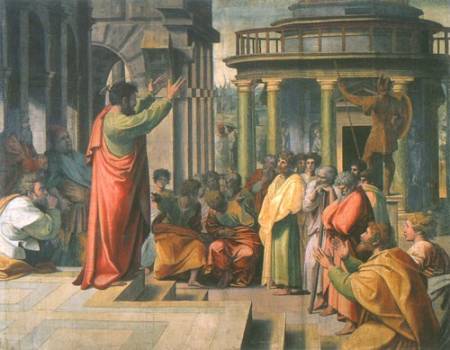

Raphael: St Paul preaching in Athens
DAY 1: Arrive Thessaloniki. Met at the airport and taken by coach to Kavala (2.30 hours). Kavala is Greece's prettiest mainland port. Paul landed here coming from Troas with Timothy and Silas and were met by Luke, the Evangelist. This ancient city was later renamed Christoupolis because it was the first European city to accept Christianity. We will see the Roman Aqueduct and the ruins of the Acropolis in this beautifully located city, known as Kavala since the 5th century.
DAY 2: PHILIPPI & KAVALA
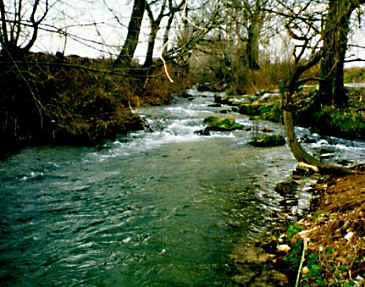 Philippi is where Paul and Silas were
imprisoned and Lydia was baptised; you will be able to walk the
Via Egnatia in Paul’s footsteps. Philippi was where Paul
preached his first evangelical sermon and baptised the first
Christians on European soil (Acts 16: 12-18). In the ruins of
ancient Philippi you will see the baptism site, a crypt where
Paul may have been imprisoned, the Acropolis, the Market Place,
Basilica and the ancient theatre. Philippi was a military town
and there were not many Jews there. Paul and Silas were charged
with the introduction of practices not observed by the Romans,
and beaten with rods - they appealed for their rights as Roman
citizens. As there was no synagogue, Sabbath worship was held
outside the city on the Gangitis River. Here Paul met a
group of women to whom he preached the gospel. Lydia, a
merchant trading purple cloth, believed Paul's message and was
baptized with members of her household. Subsequently Paul
went and lived at her home. The photo above shows the river at
Philippi where Lydia, the first European Christian, was baptised.
Philippi is where Paul and Silas were
imprisoned and Lydia was baptised; you will be able to walk the
Via Egnatia in Paul’s footsteps. Philippi was where Paul
preached his first evangelical sermon and baptised the first
Christians on European soil (Acts 16: 12-18). In the ruins of
ancient Philippi you will see the baptism site, a crypt where
Paul may have been imprisoned, the Acropolis, the Market Place,
Basilica and the ancient theatre. Philippi was a military town
and there were not many Jews there. Paul and Silas were charged
with the introduction of practices not observed by the Romans,
and beaten with rods - they appealed for their rights as Roman
citizens. As there was no synagogue, Sabbath worship was held
outside the city on the Gangitis River. Here Paul met a
group of women to whom he preached the gospel. Lydia, a
merchant trading purple cloth, believed Paul's message and was
baptized with members of her household. Subsequently Paul
went and lived at her home. The photo above shows the river at
Philippi where Lydia, the first European Christian, was baptised.
12.30. Drive to Thessaloniki via Amphipolis and the River
Strymon. Arrive at 15.30am. City sightseeing tour,
including St Demetrios’ Church and Osios David Church with
its early Christ mosaic.Evening walking tour of the centre of the
Kavala town. .
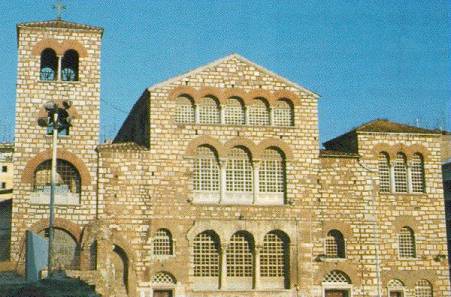 Thessaloniki (or Thessalonica or
Salonika) was called Therma in ancient times, named after the
wife of Cassander who rebuilt the city. Under the Romans it was
one of four divisions of Macedonia. Paul and Silas organised a
church there (acts 17: 1-4; 1 Thess 1:9). Paul’s visit is
mentioned in Acts 20: 1-3, and also in Philippians 4:16 and
Timothy 4:10. Paul visited the town together with Silas and
Timothy on his second missionary journey, arriving by the
Egnatian Road. He found at Thessaloniki a synagogue in which he
preached for three successive Sabbaths, basing his teaching on
the Old Testament scriptures. Some of the Jews there became
converts. Among these were probably Aristarchos and Secundus,
natives of Thessaloniki, who later accompanied Paul to Asia
during his third missionary journey. Aristarchos was also with
Paul at Ephesus and on his journey to Rome. Paul’s
activities in the town roused the anger of some Jews who
organised an attack on the house of Jason where Paul and his
companions were staying. They were not found, however, so Jason
and some of the other converts were dragged before the
magistrates and accused of harbouring men who had caused tumult
throughout the Roman world, who maintained the existence of
another king (Jesus) and acted in defiance of imperial decrees.
But since there was no proper evidence against them they were
released on bail. The converts sent Paul and Silas, and possibly
Timothy too, off to Veria for
safety.
Thessaloniki (or Thessalonica or
Salonika) was called Therma in ancient times, named after the
wife of Cassander who rebuilt the city. Under the Romans it was
one of four divisions of Macedonia. Paul and Silas organised a
church there (acts 17: 1-4; 1 Thess 1:9). Paul’s visit is
mentioned in Acts 20: 1-3, and also in Philippians 4:16 and
Timothy 4:10. Paul visited the town together with Silas and
Timothy on his second missionary journey, arriving by the
Egnatian Road. He found at Thessaloniki a synagogue in which he
preached for three successive Sabbaths, basing his teaching on
the Old Testament scriptures. Some of the Jews there became
converts. Among these were probably Aristarchos and Secundus,
natives of Thessaloniki, who later accompanied Paul to Asia
during his third missionary journey. Aristarchos was also with
Paul at Ephesus and on his journey to Rome. Paul’s
activities in the town roused the anger of some Jews who
organised an attack on the house of Jason where Paul and his
companions were staying. They were not found, however, so Jason
and some of the other converts were dragged before the
magistrates and accused of harbouring men who had caused tumult
throughout the Roman world, who maintained the existence of
another king (Jesus) and acted in defiance of imperial decrees.
But since there was no proper evidence against them they were
released on bail. The converts sent Paul and Silas, and possibly
Timothy too, off to Veria for
safety.
DAY 3: THESSALONOKI, VERIA, VERGINA &
KALAMBAKA. Depart hotel for scenic drive to Kalampaka
via Veria (the Biblical Beroea) where St Paul preached. St Paul
went to Veria from Thessaloniki, and there he found that the
Verian Jews showed a greater readiness to examine the new
teachings than many of the Jews in Thessaloniki – and his
work was more fruitful in Veria, both amongst Jews and Greeks.
But Paul’s opponents in Thessaloniki got to hear about what
was happening in Veria and they caused trouble there too, making
it necessary for Paul to leave the town and go to Athens. Proceed
to Vergina site for Philip of Macedon’s Tomb
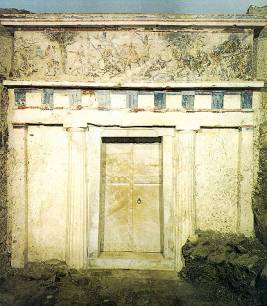 Born in 382 B.C. Philip II of Macedon was
the father of Alexander the Great. In his late twenties Philip
was appointed regent of Macedon as the king, Philip's nephew, was
only an infant. Philip overthrew his infant nephew and crowned
himself king in 359 B.C. Philip had been a Macedonian hostage
living in Thebes during his twenties and grew to think of himself
as a Greek rather than as a Macedonian. Here he learned the
politics and military strategy that enabled him to become a great
general, conqueror and king. After entering on an ambitious
career of expansion by conquest and diplomacy he became king of
Greece and was poised to conquer Persia when he was assassinated.
Philip's consolidation of his kingdom and his reduction of Greece
to relative peace made possible the campaigns of his son,
Alexander the Great. Philip and Alexander never got on well with
each other. Although Philip was proud of Alexander for taming
Bucephalus, Alexander was closer to his mother Olympias and made
no secret of this fact. Philip was a philanderer and Olympias
became a very jealous and bitter woman. The family was
essentially split when Philip married his second wife, Cleopatra,
a Macedonian. It was once said of Philip that he cared more for
his troops abroad than for his family at home.
Born in 382 B.C. Philip II of Macedon was
the father of Alexander the Great. In his late twenties Philip
was appointed regent of Macedon as the king, Philip's nephew, was
only an infant. Philip overthrew his infant nephew and crowned
himself king in 359 B.C. Philip had been a Macedonian hostage
living in Thebes during his twenties and grew to think of himself
as a Greek rather than as a Macedonian. Here he learned the
politics and military strategy that enabled him to become a great
general, conqueror and king. After entering on an ambitious
career of expansion by conquest and diplomacy he became king of
Greece and was poised to conquer Persia when he was assassinated.
Philip's consolidation of his kingdom and his reduction of Greece
to relative peace made possible the campaigns of his son,
Alexander the Great. Philip and Alexander never got on well with
each other. Although Philip was proud of Alexander for taming
Bucephalus, Alexander was closer to his mother Olympias and made
no secret of this fact. Philip was a philanderer and Olympias
became a very jealous and bitter woman. The family was
essentially split when Philip married his second wife, Cleopatra,
a Macedonian. It was once said of Philip that he cared more for
his troops abroad than for his family at home.
DAY 4: METEORA. Visit the Meteora rocks and the monasteries built on the top of rocky crags.
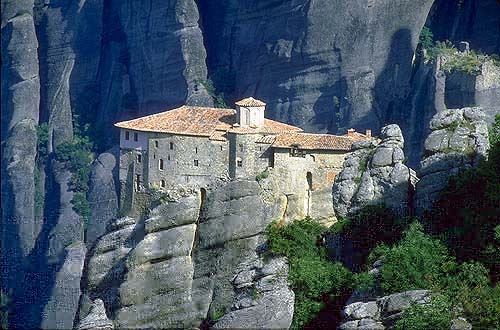
Greek Orthodox monastery of Rousanou, Meteora
An extraordinary location under the Pindos Mountains, a World Heritage Site, "Meteora" literally means, "suspended in the air". Its name refers to the 24 monasteries built on top of gigantic rocks rising towards the sky in a variety of shapes. During the 9th century monks started off by living in caves. Gradually they started to form monastic communities, building the first monasteries by the 14th century. Due to the inaccessible rocky peaks, this is where during the Ottoman Empire, Greek culture managed to keep to its roots. The monasteries were not only religious places, but artistic and academic ones as well, offering a refuge to religious people, artists, and philosophers. Until the 1920's the monasteries were accessed by rope ladders, and baskets were used for the provision of goods. Today, only 4 monasteries are inhabited and open to the public, accessible by fine paved paths. Visitors have the chance to experience these remarkable wonders, taste monastic life, walk along the original paths and admire religious treasures and local art. Dress code restrictions apply, though, and inappropriately dressed visitors are not allowed entrance. Men are obliged to wear long trousers and long sleeved tops, and women have to wear long skirts and have their shoulders covered. Skirts may be provided at the entrance of the monasteries. Be prepared for a lot of walking – it can be tiring. After lunch we depart for Athens visiting the battleground of Thermopylae en route.
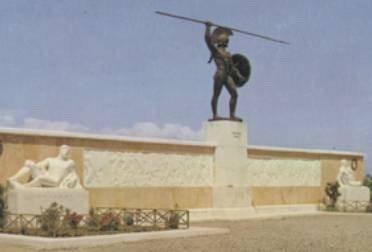 In 480 BC, as Xerxes (or Ahasueras, or
Ozymandias), the King of Persia prepared to invade Greece, the
Greeks sought advice from the Oracle at Delphi. The Oracle
pronounced that wooden walls would save Athens, but only the
death of a Spartan king would save that unwalled city from ruin.
As the Persian juggernaut crossed over a two-mile long pontoon
bridge into Europe and began its relentless march into Greece,
the Greeks temporized, argued, and dithered. Finally, Sparta sent
King Leonidas with three hundred Spartans to hold the pass at
Thermopylae against the Persian hordes. Leonidas stiffened his
contingent with Helots (Spartan serfs) and volunteers from
several other Greek city-states. Phocis, Thebes, Thespia, and a
few others swelled Leonidas' ranks to a few thousand. Upon being
told that when the Persians loosed their arrows the sky went
black, the Spartan Dienekes rejoined, "Then we shall fight
in the shade." At a point in the pass no more than 20 yards
wide Leonidas met the Persians and stopped them dead in their
tracks. For three days he and his men held the mightiest empire's
mightiest army at bay, slaughtering the flower of the Persian
army by the hundreds, if not thousands. He might have held, but a
traitorous Greek showed the Persians a mountain pass by which
they could turn Leonidas' position. Leonidas had guarded the pass
with 1,000 Phocians, but the Persian "Immortals,"
Xerxes' best unit, brushed them aside. Upon learning of this
treachery, Leonidas sent the other city-states' contingents home
and prepared for his last stand. The Thebans and Thespians
volunteered to stay, and Leonidas chose for his battleground a
wider section of the pass. He wanted as wide a front as possible
so he could kill as many Persians as possible.
In 480 BC, as Xerxes (or Ahasueras, or
Ozymandias), the King of Persia prepared to invade Greece, the
Greeks sought advice from the Oracle at Delphi. The Oracle
pronounced that wooden walls would save Athens, but only the
death of a Spartan king would save that unwalled city from ruin.
As the Persian juggernaut crossed over a two-mile long pontoon
bridge into Europe and began its relentless march into Greece,
the Greeks temporized, argued, and dithered. Finally, Sparta sent
King Leonidas with three hundred Spartans to hold the pass at
Thermopylae against the Persian hordes. Leonidas stiffened his
contingent with Helots (Spartan serfs) and volunteers from
several other Greek city-states. Phocis, Thebes, Thespia, and a
few others swelled Leonidas' ranks to a few thousand. Upon being
told that when the Persians loosed their arrows the sky went
black, the Spartan Dienekes rejoined, "Then we shall fight
in the shade." At a point in the pass no more than 20 yards
wide Leonidas met the Persians and stopped them dead in their
tracks. For three days he and his men held the mightiest empire's
mightiest army at bay, slaughtering the flower of the Persian
army by the hundreds, if not thousands. He might have held, but a
traitorous Greek showed the Persians a mountain pass by which
they could turn Leonidas' position. Leonidas had guarded the pass
with 1,000 Phocians, but the Persian "Immortals,"
Xerxes' best unit, brushed them aside. Upon learning of this
treachery, Leonidas sent the other city-states' contingents home
and prepared for his last stand. The Thebans and Thespians
volunteered to stay, and Leonidas chose for his battleground a
wider section of the pass. He wanted as wide a front as possible
so he could kill as many Persians as possible.
The Spartans joined battle with the Persians for the last time,
and the slaughter was horrific. When, as anticipated, the
Immortals took them in the rear, the Spartans retreated to a
hillock, formed what the Middle Ages would call a "Swiss
Hedgehog," and died to the last man. As prophecy foretold,
the Spartans lost their king, but saved their city, and the rest
of Greece with it. The invasion continued apace, and Athens was
sacked, with her entire population fleeing to the island of
Salamis. There in the straits between Salamis and Athens, the
Greeks lured the Persian navy to its doom. Picture above:
Monument to the Spartans at Thermopylae. Arrive Athens in the
evening. Overnight.
DAY 5: ATHENS. Morning tour of Athens including the Agora and the Acropolis. The Parthenon, the Propylaia, the Erectheion, the Areopagus. After the tour have lunch at a restaurant in Plaka at the foot of the Acropolis – there are many restaurants etc! and during your free time in Athens explore the shops, cafes etc of Plaka, the old Athens

If possible arrange an evening excursion to Cape Sounion to watch the sun set there. Cape Sounion is the southern most point of Attica where the white marble pillars of the Temple of Poseidon stand.
DAY 6: CORINTH. Drive to Corinth crossing the famous Corinth canal, visiting Elefsis en route. (The Church at Dafni is closed for restoration at the moment). At Corinth walk through the Agora, Bema and temples. Lunch in Corinth, and then continue to Kenchrea, where St Paul set sail for Syria.
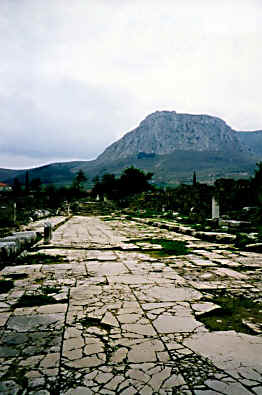 Paul spent 18 months in Corinth before
the Jews of the city charged him with breaking the law and
brought him before Gallio at the city's place of judgment
(bema). The mention of Gallio provides an anchor for New
Testament chronology, as we know from Roman sources that Gallio
was proconsul of Achaia from June 51 to May 52. Standing on
this platform, the proconsul dismissed the charges against Paul
as a dispute of Jewish law and not of a criminal nature. In
Corinth Paul met Aquila and Priscilla, Jews recently expelled by
Emperor Claudius from Rome. The three of these were
tentmakers (or leather workers) and may have had their place of
business in the city's commercial marketplace (agora). This
would have afforded Paul numerous occasions to speak with
customers and passers-by of the resurrection of Christ.
Acts notes that Paul spent each Sabbath trying to persuade Jews
and Greeks. In 1929 an inscription was found on a street in
Corinth mentioning Erastus as the one who paid for the paving of
the street in return for his appointment as a city officer.
It is likely that this is the same Erastus mentioned by Paul as
sending greetings to the church at Rome (Rom 16:23). If so,
Paul's influence apparently extended to wealthy and influential
Roman citizens of Corinth. The lower city was the location of the
Temple of Apollo while the Temple of Aphrodite dominated the
Acrocorinth. Greek writers in the 5th-4th centuries B.C.
characterized Corinth as a city of commercialised love and a
"Corinthian girl" meant a prostitute. The
Corinthian church of Paul's day struggled with worldliness and
sexual sin, both of which were typical of this cosmopolitan
city. The temple originally had 38 columns of the Doric
order; 7 are standing today. The acropolis of Corinth is known as
Acrocorinth, and it rises about 1800 feet above the surrounding
plain. At the highest summit was the Temple of Aphrodite.
Kenchrea was the port for Corinth on the eastern side of the
isthmus, and remains of the ancient harbour are visible in the
water today. Paul had his hair cut here because of a vow,
and then set sail from the harbour, concluding his 18-month stay
in Corinth (on his second journey; Acts 18:18).
Paul spent 18 months in Corinth before
the Jews of the city charged him with breaking the law and
brought him before Gallio at the city's place of judgment
(bema). The mention of Gallio provides an anchor for New
Testament chronology, as we know from Roman sources that Gallio
was proconsul of Achaia from June 51 to May 52. Standing on
this platform, the proconsul dismissed the charges against Paul
as a dispute of Jewish law and not of a criminal nature. In
Corinth Paul met Aquila and Priscilla, Jews recently expelled by
Emperor Claudius from Rome. The three of these were
tentmakers (or leather workers) and may have had their place of
business in the city's commercial marketplace (agora). This
would have afforded Paul numerous occasions to speak with
customers and passers-by of the resurrection of Christ.
Acts notes that Paul spent each Sabbath trying to persuade Jews
and Greeks. In 1929 an inscription was found on a street in
Corinth mentioning Erastus as the one who paid for the paving of
the street in return for his appointment as a city officer.
It is likely that this is the same Erastus mentioned by Paul as
sending greetings to the church at Rome (Rom 16:23). If so,
Paul's influence apparently extended to wealthy and influential
Roman citizens of Corinth. The lower city was the location of the
Temple of Apollo while the Temple of Aphrodite dominated the
Acrocorinth. Greek writers in the 5th-4th centuries B.C.
characterized Corinth as a city of commercialised love and a
"Corinthian girl" meant a prostitute. The
Corinthian church of Paul's day struggled with worldliness and
sexual sin, both of which were typical of this cosmopolitan
city. The temple originally had 38 columns of the Doric
order; 7 are standing today. The acropolis of Corinth is known as
Acrocorinth, and it rises about 1800 feet above the surrounding
plain. At the highest summit was the Temple of Aphrodite.
Kenchrea was the port for Corinth on the eastern side of the
isthmus, and remains of the ancient harbour are visible in the
water today. Paul had his hair cut here because of a vow,
and then set sail from the harbour, concluding his 18-month stay
in Corinth (on his second journey; Acts 18:18).
DAY 7 (last day): DEPARTURE FOR RETURN. Transfer from the hotel to the airport for departure.